Organizational Leadership & Interprofessional Team Development Report
VerifiedAdded on 2020/10/23
|11
|2881
|408
Report
AI Summary
This report analyzes patient-centered care within a healthcare organization, focusing on the impact of business practices, regulatory requirements, and reimbursement. It utilizes the PFCC tool to assess the organization's strengths and weaknesses across various domains, such as leadership, mission, quality improvement, personnel, and environment. The report identifies areas for improvement, particularly in family involvement in care planning, and proposes strategies based on system or change theory to increase patient-centeredness. It explores financial implications, evaluation methods, and the role of a multidisciplinary team, including general practitioners, nurses, psychologists, and occupational therapists, utilizing transformational leadership. The report emphasizes the importance of diversity within the team and communication strategies to implement and evaluate the proposed changes, aiming to enhance patient outcomes and overall healthcare quality.
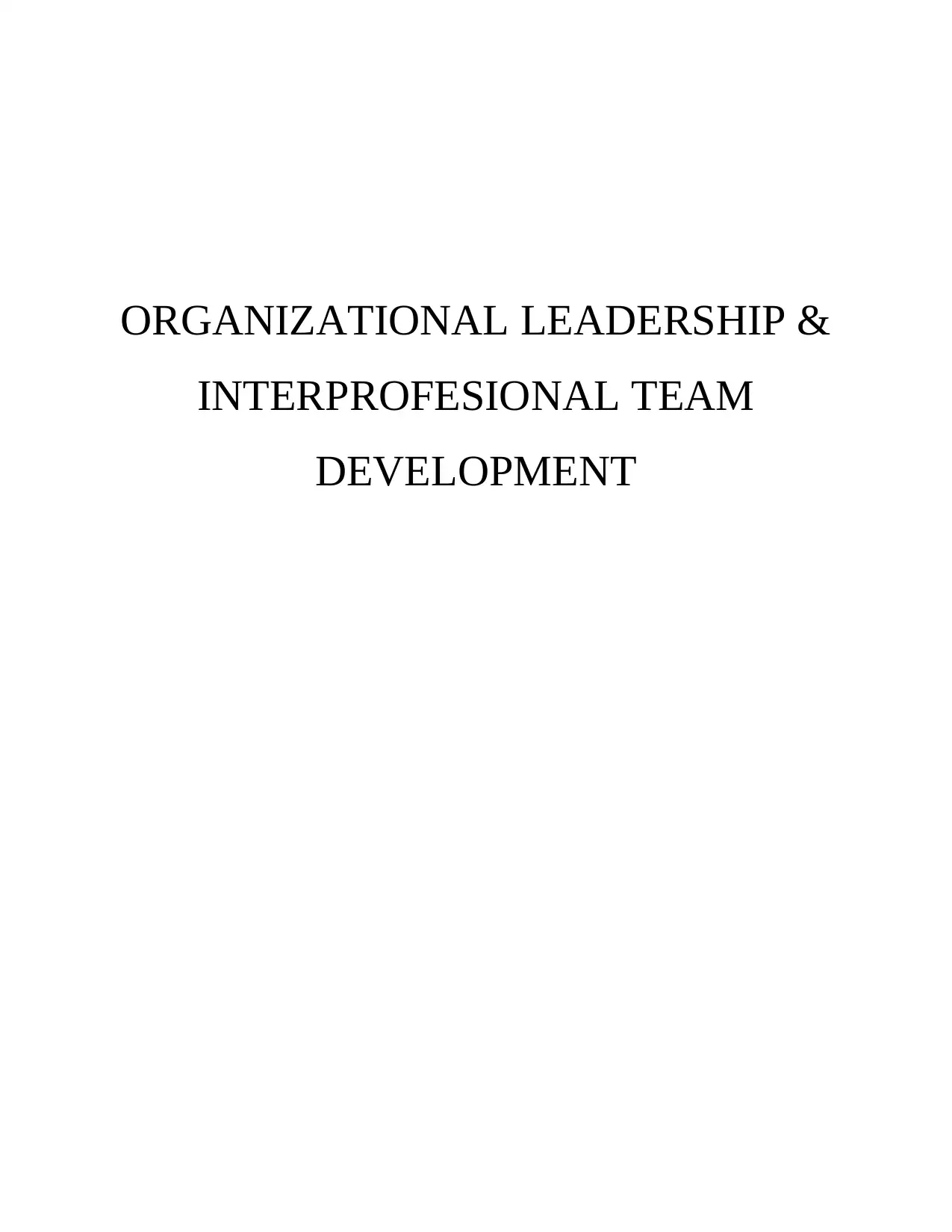
ORGANIZATIONAL LEADERSHIP &
INTERPROFESIONAL TEAM
DEVELOPMENT
INTERPROFESIONAL TEAM
DEVELOPMENT
Paraphrase This Document
Need a fresh take? Get an instant paraphrase of this document with our AI Paraphraser
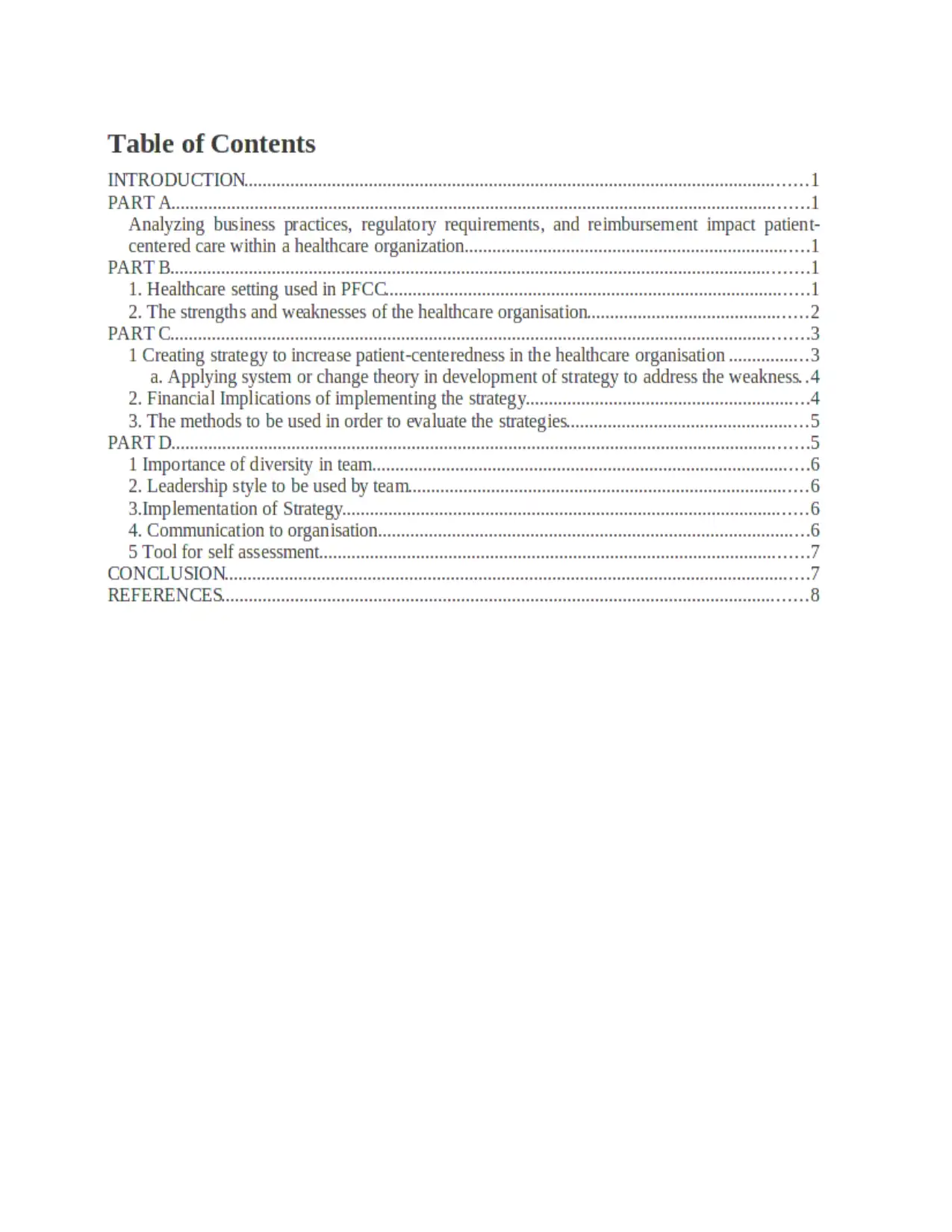
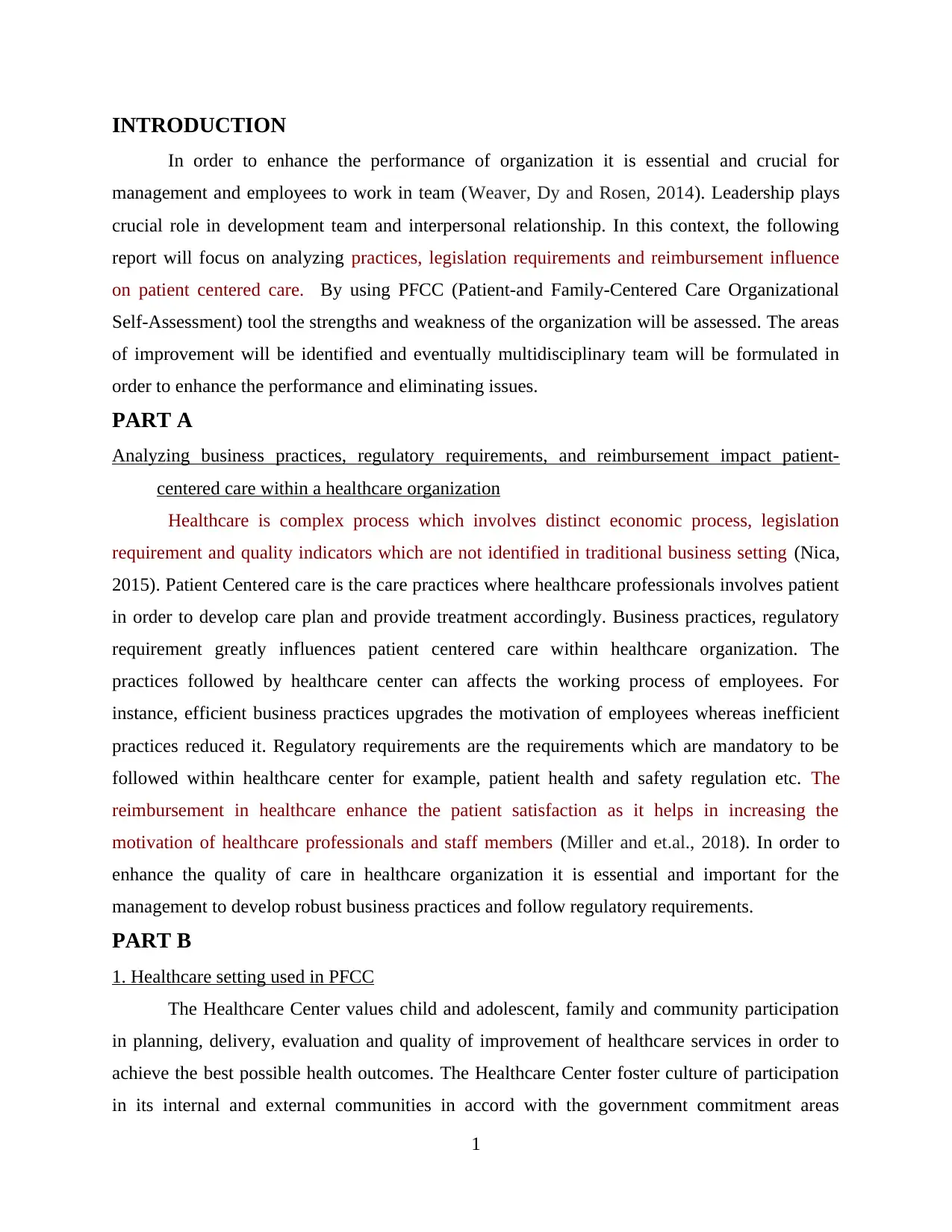
INTRODUCTION
In order to enhance the performance of organization it is essential and crucial for
management and employees to work in team (Weaver, Dy and Rosen, 2014). Leadership plays
crucial role in development team and interpersonal relationship. In this context, the following
report will focus on analyzing practices, legislation requirements and reimbursement influence
on patient centered care. By using PFCC (Patient-and Family-Centered Care Organizational
Self-Assessment) tool the strengths and weakness of the organization will be assessed. The areas
of improvement will be identified and eventually multidisciplinary team will be formulated in
order to enhance the performance and eliminating issues.
PART A
Analyzing business practices, regulatory requirements, and reimbursement impact patient-
centered care within a healthcare organization
Healthcare is complex process which involves distinct economic process, legislation
requirement and quality indicators which are not identified in traditional business setting (Nica,
2015). Patient Centered care is the care practices where healthcare professionals involves patient
in order to develop care plan and provide treatment accordingly. Business practices, regulatory
requirement greatly influences patient centered care within healthcare organization. The
practices followed by healthcare center can affects the working process of employees. For
instance, efficient business practices upgrades the motivation of employees whereas inefficient
practices reduced it. Regulatory requirements are the requirements which are mandatory to be
followed within healthcare center for example, patient health and safety regulation etc. The
reimbursement in healthcare enhance the patient satisfaction as it helps in increasing the
motivation of healthcare professionals and staff members (Miller and et.al., 2018). In order to
enhance the quality of care in healthcare organization it is essential and important for the
management to develop robust business practices and follow regulatory requirements.
PART B
1. Healthcare setting used in PFCC
The Healthcare Center values child and adolescent, family and community participation
in planning, delivery, evaluation and quality of improvement of healthcare services in order to
achieve the best possible health outcomes. The Healthcare Center foster culture of participation
in its internal and external communities in accord with the government commitment areas
1
In order to enhance the performance of organization it is essential and crucial for
management and employees to work in team (Weaver, Dy and Rosen, 2014). Leadership plays
crucial role in development team and interpersonal relationship. In this context, the following
report will focus on analyzing practices, legislation requirements and reimbursement influence
on patient centered care. By using PFCC (Patient-and Family-Centered Care Organizational
Self-Assessment) tool the strengths and weakness of the organization will be assessed. The areas
of improvement will be identified and eventually multidisciplinary team will be formulated in
order to enhance the performance and eliminating issues.
PART A
Analyzing business practices, regulatory requirements, and reimbursement impact patient-
centered care within a healthcare organization
Healthcare is complex process which involves distinct economic process, legislation
requirement and quality indicators which are not identified in traditional business setting (Nica,
2015). Patient Centered care is the care practices where healthcare professionals involves patient
in order to develop care plan and provide treatment accordingly. Business practices, regulatory
requirement greatly influences patient centered care within healthcare organization. The
practices followed by healthcare center can affects the working process of employees. For
instance, efficient business practices upgrades the motivation of employees whereas inefficient
practices reduced it. Regulatory requirements are the requirements which are mandatory to be
followed within healthcare center for example, patient health and safety regulation etc. The
reimbursement in healthcare enhance the patient satisfaction as it helps in increasing the
motivation of healthcare professionals and staff members (Miller and et.al., 2018). In order to
enhance the quality of care in healthcare organization it is essential and important for the
management to develop robust business practices and follow regulatory requirements.
PART B
1. Healthcare setting used in PFCC
The Healthcare Center values child and adolescent, family and community participation
in planning, delivery, evaluation and quality of improvement of healthcare services in order to
achieve the best possible health outcomes. The Healthcare Center foster culture of participation
in its internal and external communities in accord with the government commitment areas
1
⊘ This is a preview!⊘
Do you want full access?
Subscribe today to unlock all pages.

Trusted by 1+ million students worldwide
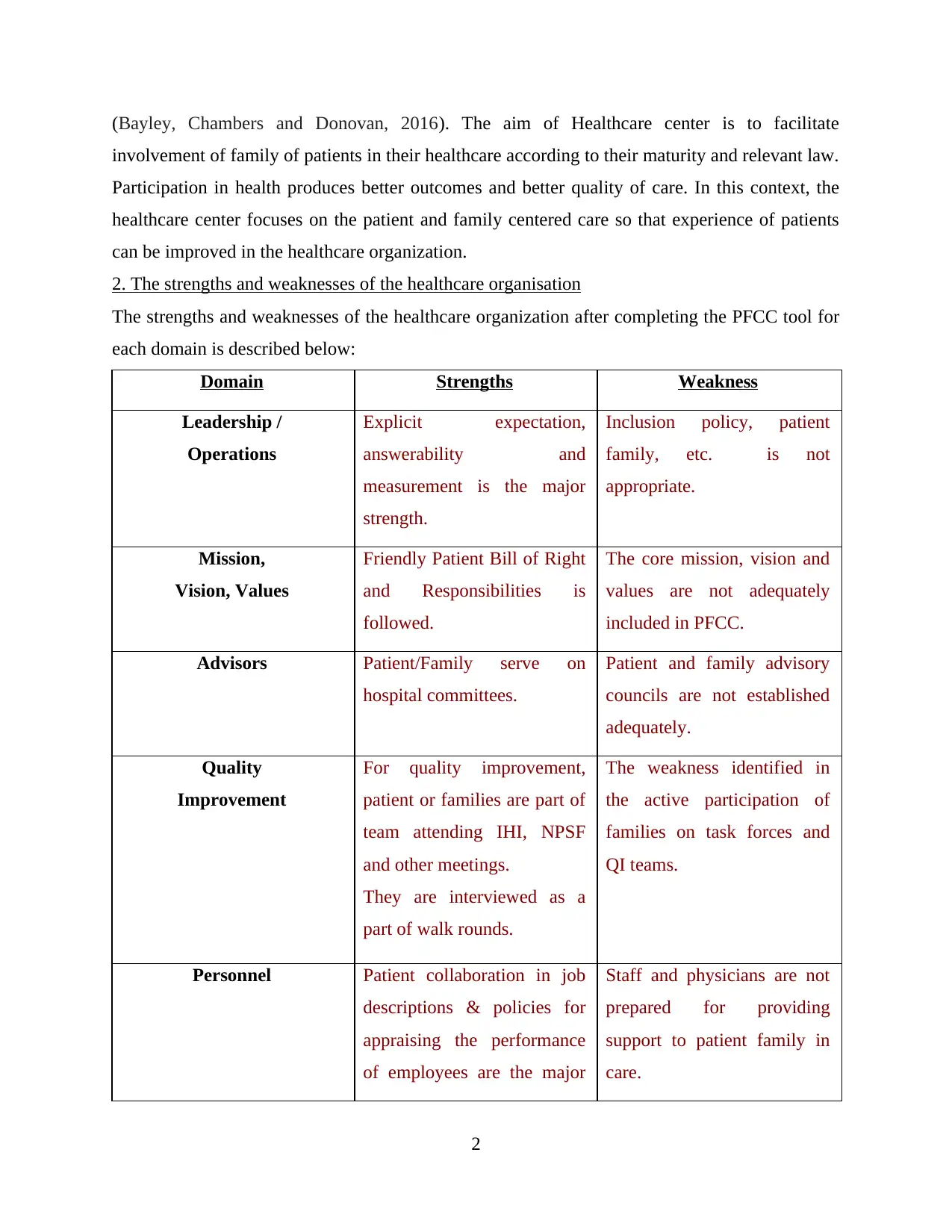
(Bayley, Chambers and Donovan, 2016). The aim of Healthcare center is to facilitate
involvement of family of patients in their healthcare according to their maturity and relevant law.
Participation in health produces better outcomes and better quality of care. In this context, the
healthcare center focuses on the patient and family centered care so that experience of patients
can be improved in the healthcare organization.
2. The strengths and weaknesses of the healthcare organisation
The strengths and weaknesses of the healthcare organization after completing the PFCC tool for
each domain is described below:
Domain Strengths Weakness
Leadership /
Operations
Explicit expectation,
answerability and
measurement is the major
strength.
Inclusion policy, patient
family, etc. is not
appropriate.
Mission,
Vision, Values
Friendly Patient Bill of Right
and Responsibilities is
followed.
The core mission, vision and
values are not adequately
included in PFCC.
Advisors Patient/Family serve on
hospital committees.
Patient and family advisory
councils are not established
adequately.
Quality
Improvement
For quality improvement,
patient or families are part of
team attending IHI, NPSF
and other meetings.
They are interviewed as a
part of walk rounds.
The weakness identified in
the active participation of
families on task forces and
QI teams.
Personnel Patient collaboration in job
descriptions & policies for
appraising the performance
of employees are the major
Staff and physicians are not
prepared for providing
support to patient family in
care.
2
involvement of family of patients in their healthcare according to their maturity and relevant law.
Participation in health produces better outcomes and better quality of care. In this context, the
healthcare center focuses on the patient and family centered care so that experience of patients
can be improved in the healthcare organization.
2. The strengths and weaknesses of the healthcare organisation
The strengths and weaknesses of the healthcare organization after completing the PFCC tool for
each domain is described below:
Domain Strengths Weakness
Leadership /
Operations
Explicit expectation,
answerability and
measurement is the major
strength.
Inclusion policy, patient
family, etc. is not
appropriate.
Mission,
Vision, Values
Friendly Patient Bill of Right
and Responsibilities is
followed.
The core mission, vision and
values are not adequately
included in PFCC.
Advisors Patient/Family serve on
hospital committees.
Patient and family advisory
councils are not established
adequately.
Quality
Improvement
For quality improvement,
patient or families are part of
team attending IHI, NPSF
and other meetings.
They are interviewed as a
part of walk rounds.
The weakness identified in
the active participation of
families on task forces and
QI teams.
Personnel Patient collaboration in job
descriptions & policies for
appraising the performance
of employees are the major
Staff and physicians are not
prepared for providing
support to patient family in
care.
2
Paraphrase This Document
Need a fresh take? Get an instant paraphrase of this document with our AI Paraphraser
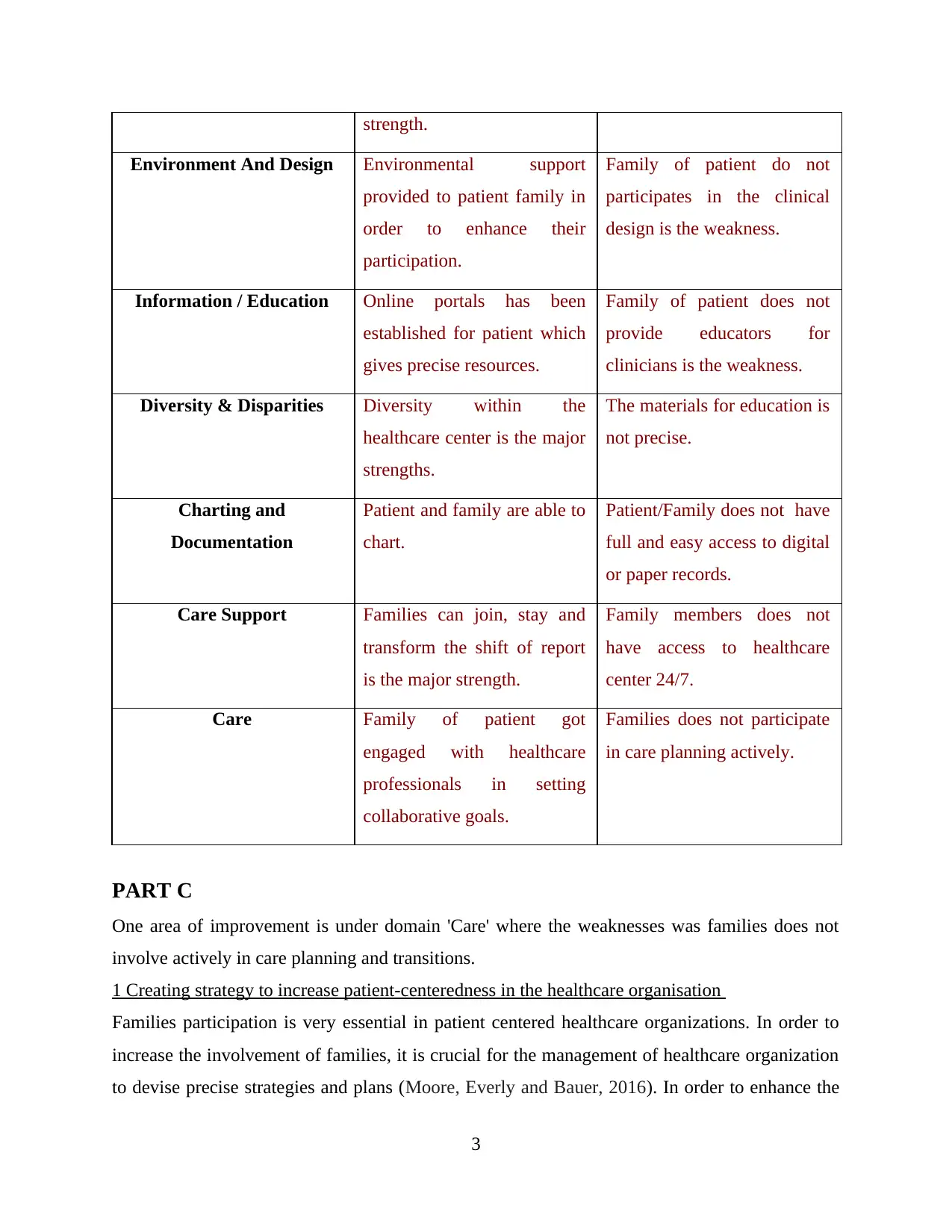
strength.
Environment And Design Environmental support
provided to patient family in
order to enhance their
participation.
Family of patient do not
participates in the clinical
design is the weakness.
Information / Education Online portals has been
established for patient which
gives precise resources.
Family of patient does not
provide educators for
clinicians is the weakness.
Diversity & Disparities Diversity within the
healthcare center is the major
strengths.
The materials for education is
not precise.
Charting and
Documentation
Patient and family are able to
chart.
Patient/Family does not have
full and easy access to digital
or paper records.
Care Support Families can join, stay and
transform the shift of report
is the major strength.
Family members does not
have access to healthcare
center 24/7.
Care Family of patient got
engaged with healthcare
professionals in setting
collaborative goals.
Families does not participate
in care planning actively.
PART C
One area of improvement is under domain 'Care' where the weaknesses was families does not
involve actively in care planning and transitions.
1 Creating strategy to increase patient-centeredness in the healthcare organisation
Families participation is very essential in patient centered healthcare organizations. In order to
increase the involvement of families, it is crucial for the management of healthcare organization
to devise precise strategies and plans (Moore, Everly and Bauer, 2016). In order to enhance the
3
Environment And Design Environmental support
provided to patient family in
order to enhance their
participation.
Family of patient do not
participates in the clinical
design is the weakness.
Information / Education Online portals has been
established for patient which
gives precise resources.
Family of patient does not
provide educators for
clinicians is the weakness.
Diversity & Disparities Diversity within the
healthcare center is the major
strengths.
The materials for education is
not precise.
Charting and
Documentation
Patient and family are able to
chart.
Patient/Family does not have
full and easy access to digital
or paper records.
Care Support Families can join, stay and
transform the shift of report
is the major strength.
Family members does not
have access to healthcare
center 24/7.
Care Family of patient got
engaged with healthcare
professionals in setting
collaborative goals.
Families does not participate
in care planning actively.
PART C
One area of improvement is under domain 'Care' where the weaknesses was families does not
involve actively in care planning and transitions.
1 Creating strategy to increase patient-centeredness in the healthcare organisation
Families participation is very essential in patient centered healthcare organizations. In order to
increase the involvement of families, it is crucial for the management of healthcare organization
to devise precise strategies and plans (Moore, Everly and Bauer, 2016). In order to enhance the
3
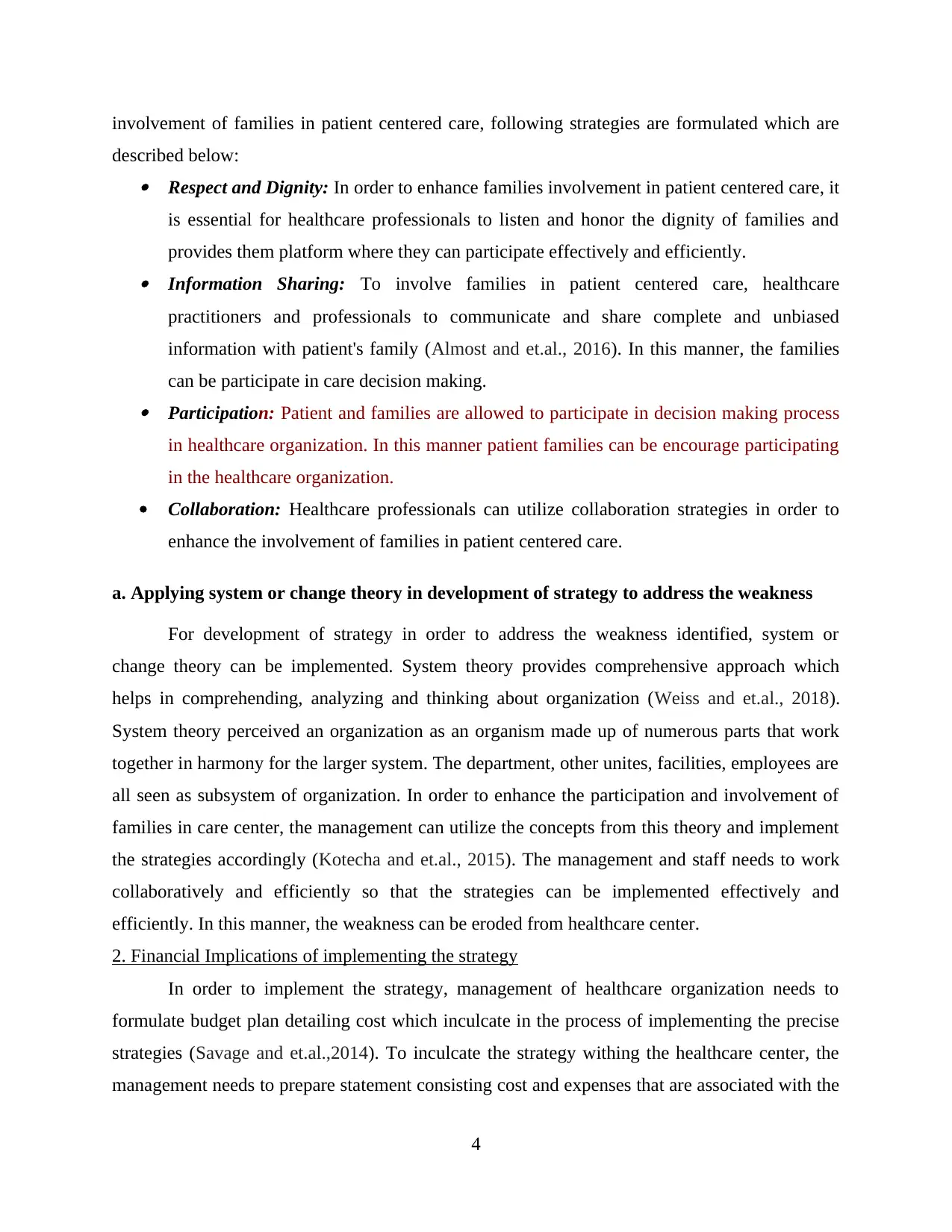
involvement of families in patient centered care, following strategies are formulated which are
described below: Respect and Dignity: In order to enhance families involvement in patient centered care, it
is essential for healthcare professionals to listen and honor the dignity of families and
provides them platform where they can participate effectively and efficiently. Information Sharing: To involve families in patient centered care, healthcare
practitioners and professionals to communicate and share complete and unbiased
information with patient's family (Almost and et.al., 2016). In this manner, the families
can be participate in care decision making. Participation: Patient and families are allowed to participate in decision making process
in healthcare organization. In this manner patient families can be encourage participating
in the healthcare organization.
Collaboration: Healthcare professionals can utilize collaboration strategies in order to
enhance the involvement of families in patient centered care.
a. Applying system or change theory in development of strategy to address the weakness
For development of strategy in order to address the weakness identified, system or
change theory can be implemented. System theory provides comprehensive approach which
helps in comprehending, analyzing and thinking about organization (Weiss and et.al., 2018).
System theory perceived an organization as an organism made up of numerous parts that work
together in harmony for the larger system. The department, other unites, facilities, employees are
all seen as subsystem of organization. In order to enhance the participation and involvement of
families in care center, the management can utilize the concepts from this theory and implement
the strategies accordingly (Kotecha and et.al., 2015). The management and staff needs to work
collaboratively and efficiently so that the strategies can be implemented effectively and
efficiently. In this manner, the weakness can be eroded from healthcare center.
2. Financial Implications of implementing the strategy
In order to implement the strategy, management of healthcare organization needs to
formulate budget plan detailing cost which inculcate in the process of implementing the precise
strategies (Savage and et.al.,2014). To inculcate the strategy withing the healthcare center, the
management needs to prepare statement consisting cost and expenses that are associated with the
4
described below: Respect and Dignity: In order to enhance families involvement in patient centered care, it
is essential for healthcare professionals to listen and honor the dignity of families and
provides them platform where they can participate effectively and efficiently. Information Sharing: To involve families in patient centered care, healthcare
practitioners and professionals to communicate and share complete and unbiased
information with patient's family (Almost and et.al., 2016). In this manner, the families
can be participate in care decision making. Participation: Patient and families are allowed to participate in decision making process
in healthcare organization. In this manner patient families can be encourage participating
in the healthcare organization.
Collaboration: Healthcare professionals can utilize collaboration strategies in order to
enhance the involvement of families in patient centered care.
a. Applying system or change theory in development of strategy to address the weakness
For development of strategy in order to address the weakness identified, system or
change theory can be implemented. System theory provides comprehensive approach which
helps in comprehending, analyzing and thinking about organization (Weiss and et.al., 2018).
System theory perceived an organization as an organism made up of numerous parts that work
together in harmony for the larger system. The department, other unites, facilities, employees are
all seen as subsystem of organization. In order to enhance the participation and involvement of
families in care center, the management can utilize the concepts from this theory and implement
the strategies accordingly (Kotecha and et.al., 2015). The management and staff needs to work
collaboratively and efficiently so that the strategies can be implemented effectively and
efficiently. In this manner, the weakness can be eroded from healthcare center.
2. Financial Implications of implementing the strategy
In order to implement the strategy, management of healthcare organization needs to
formulate budget plan detailing cost which inculcate in the process of implementing the precise
strategies (Savage and et.al.,2014). To inculcate the strategy withing the healthcare center, the
management needs to prepare statement consisting cost and expenses that are associated with the
4
⊘ This is a preview!⊘
Do you want full access?
Subscribe today to unlock all pages.

Trusted by 1+ million students worldwide
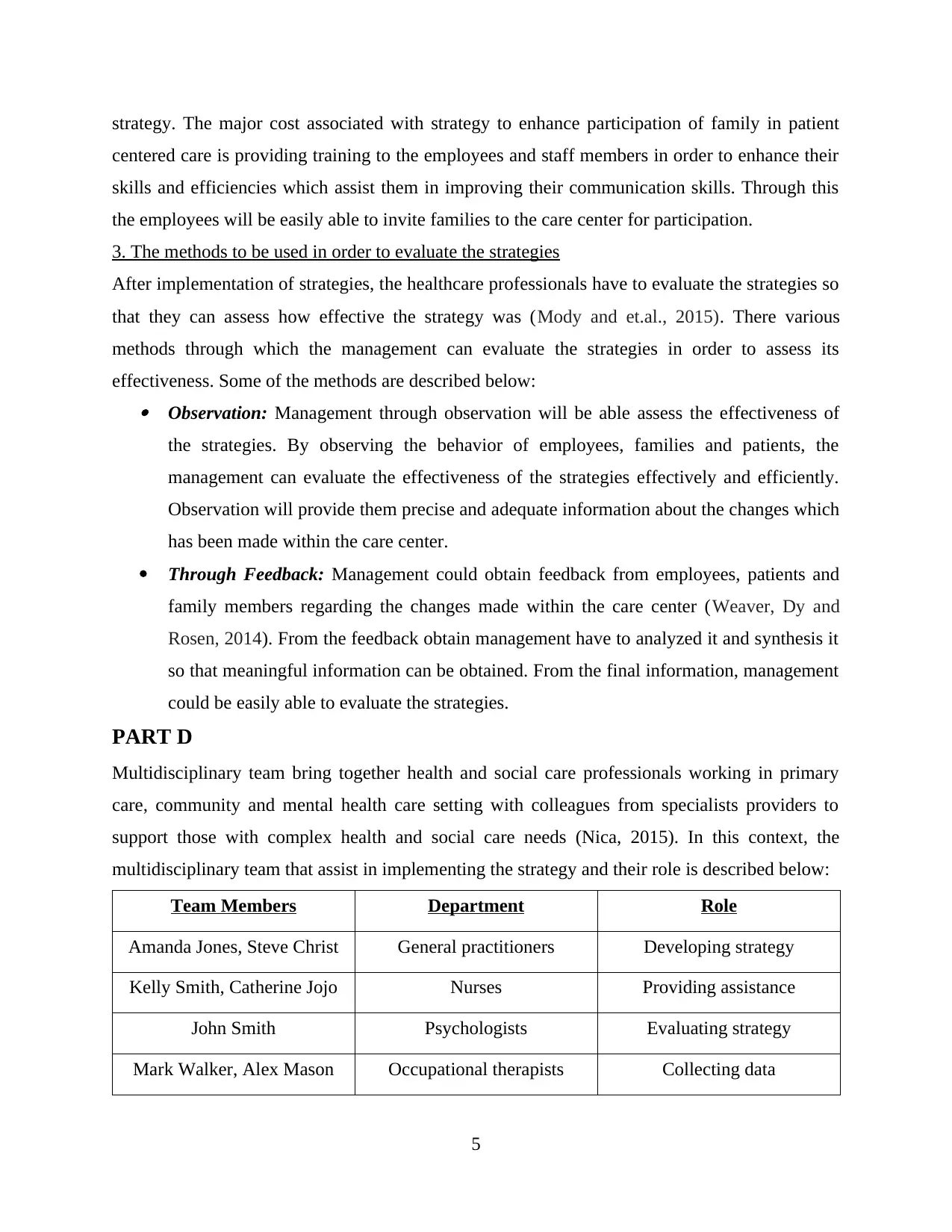
strategy. The major cost associated with strategy to enhance participation of family in patient
centered care is providing training to the employees and staff members in order to enhance their
skills and efficiencies which assist them in improving their communication skills. Through this
the employees will be easily able to invite families to the care center for participation.
3. The methods to be used in order to evaluate the strategies
After implementation of strategies, the healthcare professionals have to evaluate the strategies so
that they can assess how effective the strategy was (Mody and et.al., 2015). There various
methods through which the management can evaluate the strategies in order to assess its
effectiveness. Some of the methods are described below: Observation: Management through observation will be able assess the effectiveness of
the strategies. By observing the behavior of employees, families and patients, the
management can evaluate the effectiveness of the strategies effectively and efficiently.
Observation will provide them precise and adequate information about the changes which
has been made within the care center.
Through Feedback: Management could obtain feedback from employees, patients and
family members regarding the changes made within the care center (Weaver, Dy and
Rosen, 2014). From the feedback obtain management have to analyzed it and synthesis it
so that meaningful information can be obtained. From the final information, management
could be easily able to evaluate the strategies.
PART D
Multidisciplinary team bring together health and social care professionals working in primary
care, community and mental health care setting with colleagues from specialists providers to
support those with complex health and social care needs (Nica, 2015). In this context, the
multidisciplinary team that assist in implementing the strategy and their role is described below:
Team Members Department Role
Amanda Jones, Steve Christ General practitioners Developing strategy
Kelly Smith, Catherine Jojo Nurses Providing assistance
John Smith Psychologists Evaluating strategy
Mark Walker, Alex Mason Occupational therapists Collecting data
5
centered care is providing training to the employees and staff members in order to enhance their
skills and efficiencies which assist them in improving their communication skills. Through this
the employees will be easily able to invite families to the care center for participation.
3. The methods to be used in order to evaluate the strategies
After implementation of strategies, the healthcare professionals have to evaluate the strategies so
that they can assess how effective the strategy was (Mody and et.al., 2015). There various
methods through which the management can evaluate the strategies in order to assess its
effectiveness. Some of the methods are described below: Observation: Management through observation will be able assess the effectiveness of
the strategies. By observing the behavior of employees, families and patients, the
management can evaluate the effectiveness of the strategies effectively and efficiently.
Observation will provide them precise and adequate information about the changes which
has been made within the care center.
Through Feedback: Management could obtain feedback from employees, patients and
family members regarding the changes made within the care center (Weaver, Dy and
Rosen, 2014). From the feedback obtain management have to analyzed it and synthesis it
so that meaningful information can be obtained. From the final information, management
could be easily able to evaluate the strategies.
PART D
Multidisciplinary team bring together health and social care professionals working in primary
care, community and mental health care setting with colleagues from specialists providers to
support those with complex health and social care needs (Nica, 2015). In this context, the
multidisciplinary team that assist in implementing the strategy and their role is described below:
Team Members Department Role
Amanda Jones, Steve Christ General practitioners Developing strategy
Kelly Smith, Catherine Jojo Nurses Providing assistance
John Smith Psychologists Evaluating strategy
Mark Walker, Alex Mason Occupational therapists Collecting data
5
Paraphrase This Document
Need a fresh take? Get an instant paraphrase of this document with our AI Paraphraser
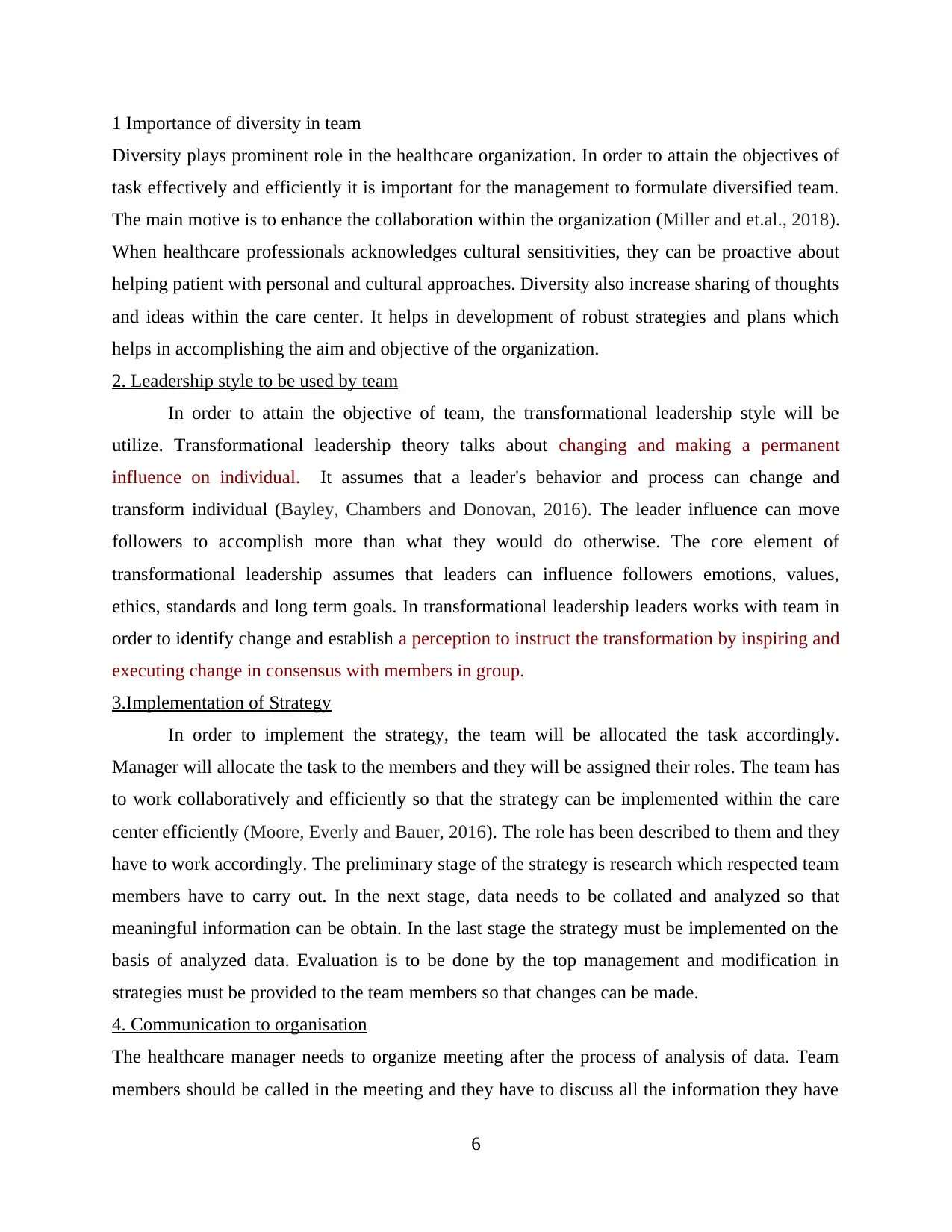
1 Importance of diversity in team
Diversity plays prominent role in the healthcare organization. In order to attain the objectives of
task effectively and efficiently it is important for the management to formulate diversified team.
The main motive is to enhance the collaboration within the organization (Miller and et.al., 2018).
When healthcare professionals acknowledges cultural sensitivities, they can be proactive about
helping patient with personal and cultural approaches. Diversity also increase sharing of thoughts
and ideas within the care center. It helps in development of robust strategies and plans which
helps in accomplishing the aim and objective of the organization.
2. Leadership style to be used by team
In order to attain the objective of team, the transformational leadership style will be
utilize. Transformational leadership theory talks about changing and making a permanent
influence on individual. It assumes that a leader's behavior and process can change and
transform individual (Bayley, Chambers and Donovan, 2016). The leader influence can move
followers to accomplish more than what they would do otherwise. The core element of
transformational leadership assumes that leaders can influence followers emotions, values,
ethics, standards and long term goals. In transformational leadership leaders works with team in
order to identify change and establish a perception to instruct the transformation by inspiring and
executing change in consensus with members in group.
3.Implementation of Strategy
In order to implement the strategy, the team will be allocated the task accordingly.
Manager will allocate the task to the members and they will be assigned their roles. The team has
to work collaboratively and efficiently so that the strategy can be implemented within the care
center efficiently (Moore, Everly and Bauer, 2016). The role has been described to them and they
have to work accordingly. The preliminary stage of the strategy is research which respected team
members have to carry out. In the next stage, data needs to be collated and analyzed so that
meaningful information can be obtain. In the last stage the strategy must be implemented on the
basis of analyzed data. Evaluation is to be done by the top management and modification in
strategies must be provided to the team members so that changes can be made.
4. Communication to organisation
The healthcare manager needs to organize meeting after the process of analysis of data. Team
members should be called in the meeting and they have to discuss all the information they have
6
Diversity plays prominent role in the healthcare organization. In order to attain the objectives of
task effectively and efficiently it is important for the management to formulate diversified team.
The main motive is to enhance the collaboration within the organization (Miller and et.al., 2018).
When healthcare professionals acknowledges cultural sensitivities, they can be proactive about
helping patient with personal and cultural approaches. Diversity also increase sharing of thoughts
and ideas within the care center. It helps in development of robust strategies and plans which
helps in accomplishing the aim and objective of the organization.
2. Leadership style to be used by team
In order to attain the objective of team, the transformational leadership style will be
utilize. Transformational leadership theory talks about changing and making a permanent
influence on individual. It assumes that a leader's behavior and process can change and
transform individual (Bayley, Chambers and Donovan, 2016). The leader influence can move
followers to accomplish more than what they would do otherwise. The core element of
transformational leadership assumes that leaders can influence followers emotions, values,
ethics, standards and long term goals. In transformational leadership leaders works with team in
order to identify change and establish a perception to instruct the transformation by inspiring and
executing change in consensus with members in group.
3.Implementation of Strategy
In order to implement the strategy, the team will be allocated the task accordingly.
Manager will allocate the task to the members and they will be assigned their roles. The team has
to work collaboratively and efficiently so that the strategy can be implemented within the care
center efficiently (Moore, Everly and Bauer, 2016). The role has been described to them and they
have to work accordingly. The preliminary stage of the strategy is research which respected team
members have to carry out. In the next stage, data needs to be collated and analyzed so that
meaningful information can be obtain. In the last stage the strategy must be implemented on the
basis of analyzed data. Evaluation is to be done by the top management and modification in
strategies must be provided to the team members so that changes can be made.
4. Communication to organisation
The healthcare manager needs to organize meeting after the process of analysis of data. Team
members should be called in the meeting and they have to discuss all the information they have
6
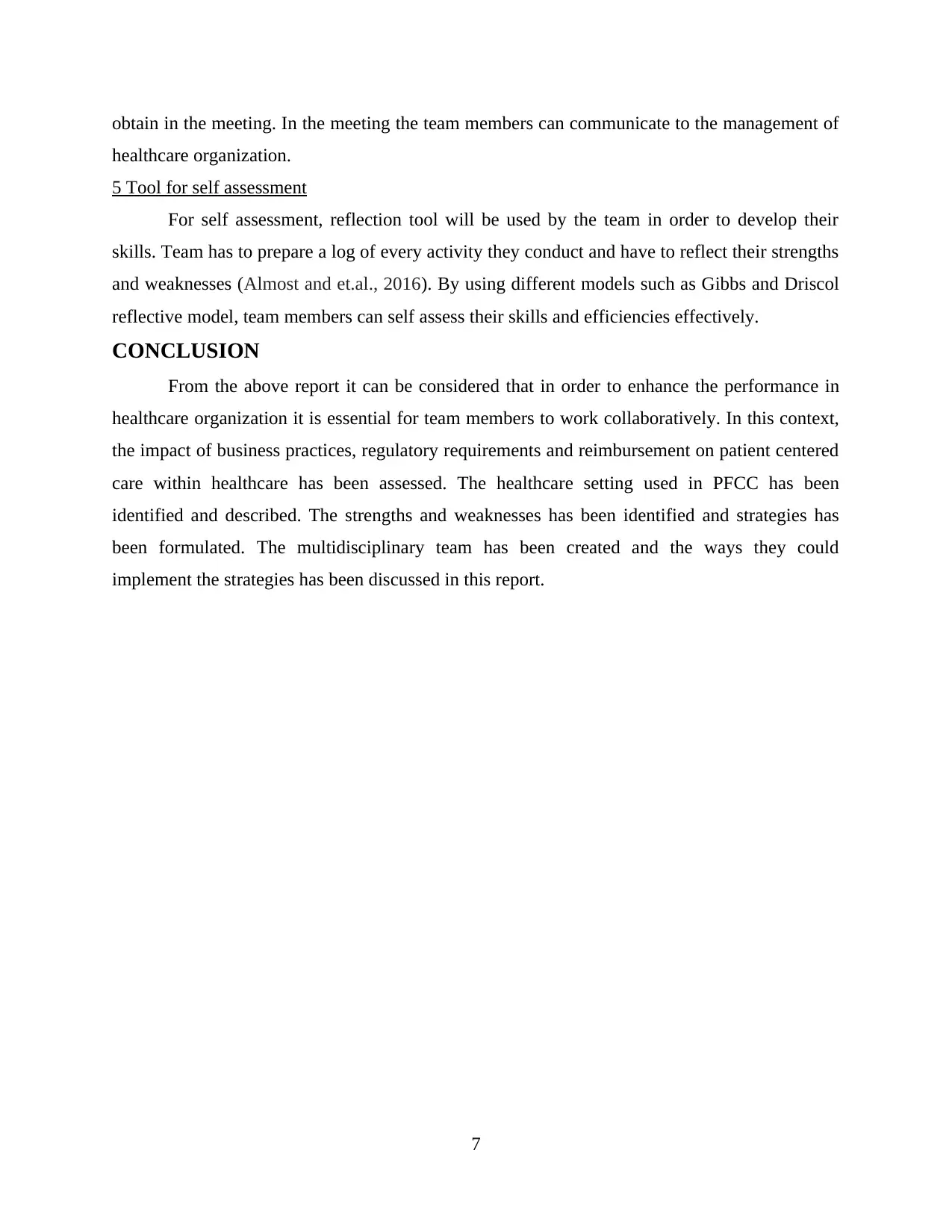
obtain in the meeting. In the meeting the team members can communicate to the management of
healthcare organization.
5 Tool for self assessment
For self assessment, reflection tool will be used by the team in order to develop their
skills. Team has to prepare a log of every activity they conduct and have to reflect their strengths
and weaknesses (Almost and et.al., 2016). By using different models such as Gibbs and Driscol
reflective model, team members can self assess their skills and efficiencies effectively.
CONCLUSION
From the above report it can be considered that in order to enhance the performance in
healthcare organization it is essential for team members to work collaboratively. In this context,
the impact of business practices, regulatory requirements and reimbursement on patient centered
care within healthcare has been assessed. The healthcare setting used in PFCC has been
identified and described. The strengths and weaknesses has been identified and strategies has
been formulated. The multidisciplinary team has been created and the ways they could
implement the strategies has been discussed in this report.
7
healthcare organization.
5 Tool for self assessment
For self assessment, reflection tool will be used by the team in order to develop their
skills. Team has to prepare a log of every activity they conduct and have to reflect their strengths
and weaknesses (Almost and et.al., 2016). By using different models such as Gibbs and Driscol
reflective model, team members can self assess their skills and efficiencies effectively.
CONCLUSION
From the above report it can be considered that in order to enhance the performance in
healthcare organization it is essential for team members to work collaboratively. In this context,
the impact of business practices, regulatory requirements and reimbursement on patient centered
care within healthcare has been assessed. The healthcare setting used in PFCC has been
identified and described. The strengths and weaknesses has been identified and strategies has
been formulated. The multidisciplinary team has been created and the ways they could
implement the strategies has been discussed in this report.
7
⊘ This is a preview!⊘
Do you want full access?
Subscribe today to unlock all pages.

Trusted by 1+ million students worldwide
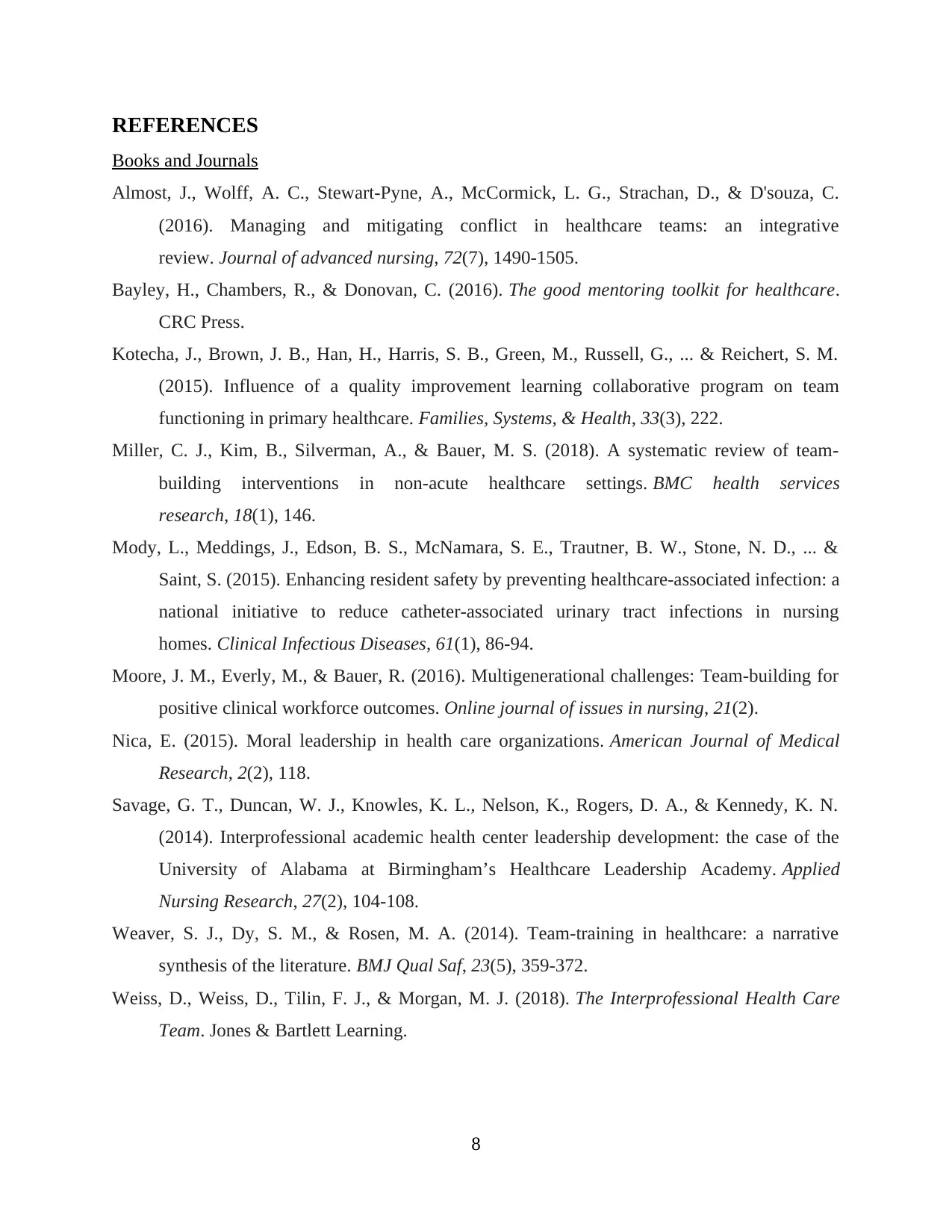
REFERENCES
Books and Journals
Almost, J., Wolff, A. C., Stewart‐Pyne, A., McCormick, L. G., Strachan, D., & D'souza, C.
(2016). Managing and mitigating conflict in healthcare teams: an integrative
review. Journal of advanced nursing, 72(7), 1490-1505.
Bayley, H., Chambers, R., & Donovan, C. (2016). The good mentoring toolkit for healthcare.
CRC Press.
Kotecha, J., Brown, J. B., Han, H., Harris, S. B., Green, M., Russell, G., ... & Reichert, S. M.
(2015). Influence of a quality improvement learning collaborative program on team
functioning in primary healthcare. Families, Systems, & Health, 33(3), 222.
Miller, C. J., Kim, B., Silverman, A., & Bauer, M. S. (2018). A systematic review of team-
building interventions in non-acute healthcare settings. BMC health services
research, 18(1), 146.
Mody, L., Meddings, J., Edson, B. S., McNamara, S. E., Trautner, B. W., Stone, N. D., ... &
Saint, S. (2015). Enhancing resident safety by preventing healthcare-associated infection: a
national initiative to reduce catheter-associated urinary tract infections in nursing
homes. Clinical Infectious Diseases, 61(1), 86-94.
Moore, J. M., Everly, M., & Bauer, R. (2016). Multigenerational challenges: Team-building for
positive clinical workforce outcomes. Online journal of issues in nursing, 21(2).
Nica, E. (2015). Moral leadership in health care organizations. American Journal of Medical
Research, 2(2), 118.
Savage, G. T., Duncan, W. J., Knowles, K. L., Nelson, K., Rogers, D. A., & Kennedy, K. N.
(2014). Interprofessional academic health center leadership development: the case of the
University of Alabama at Birmingham’s Healthcare Leadership Academy. Applied
Nursing Research, 27(2), 104-108.
Weaver, S. J., Dy, S. M., & Rosen, M. A. (2014). Team-training in healthcare: a narrative
synthesis of the literature. BMJ Qual Saf, 23(5), 359-372.
Weiss, D., Weiss, D., Tilin, F. J., & Morgan, M. J. (2018). The Interprofessional Health Care
Team. Jones & Bartlett Learning.
8
Books and Journals
Almost, J., Wolff, A. C., Stewart‐Pyne, A., McCormick, L. G., Strachan, D., & D'souza, C.
(2016). Managing and mitigating conflict in healthcare teams: an integrative
review. Journal of advanced nursing, 72(7), 1490-1505.
Bayley, H., Chambers, R., & Donovan, C. (2016). The good mentoring toolkit for healthcare.
CRC Press.
Kotecha, J., Brown, J. B., Han, H., Harris, S. B., Green, M., Russell, G., ... & Reichert, S. M.
(2015). Influence of a quality improvement learning collaborative program on team
functioning in primary healthcare. Families, Systems, & Health, 33(3), 222.
Miller, C. J., Kim, B., Silverman, A., & Bauer, M. S. (2018). A systematic review of team-
building interventions in non-acute healthcare settings. BMC health services
research, 18(1), 146.
Mody, L., Meddings, J., Edson, B. S., McNamara, S. E., Trautner, B. W., Stone, N. D., ... &
Saint, S. (2015). Enhancing resident safety by preventing healthcare-associated infection: a
national initiative to reduce catheter-associated urinary tract infections in nursing
homes. Clinical Infectious Diseases, 61(1), 86-94.
Moore, J. M., Everly, M., & Bauer, R. (2016). Multigenerational challenges: Team-building for
positive clinical workforce outcomes. Online journal of issues in nursing, 21(2).
Nica, E. (2015). Moral leadership in health care organizations. American Journal of Medical
Research, 2(2), 118.
Savage, G. T., Duncan, W. J., Knowles, K. L., Nelson, K., Rogers, D. A., & Kennedy, K. N.
(2014). Interprofessional academic health center leadership development: the case of the
University of Alabama at Birmingham’s Healthcare Leadership Academy. Applied
Nursing Research, 27(2), 104-108.
Weaver, S. J., Dy, S. M., & Rosen, M. A. (2014). Team-training in healthcare: a narrative
synthesis of the literature. BMJ Qual Saf, 23(5), 359-372.
Weiss, D., Weiss, D., Tilin, F. J., & Morgan, M. J. (2018). The Interprofessional Health Care
Team. Jones & Bartlett Learning.
8
Paraphrase This Document
Need a fresh take? Get an instant paraphrase of this document with our AI Paraphraser

9
1 out of 11
Related Documents
Your All-in-One AI-Powered Toolkit for Academic Success.
+13062052269
info@desklib.com
Available 24*7 on WhatsApp / Email
![[object Object]](/_next/static/media/star-bottom.7253800d.svg)
Unlock your academic potential
Copyright © 2020–2025 A2Z Services. All Rights Reserved. Developed and managed by ZUCOL.




